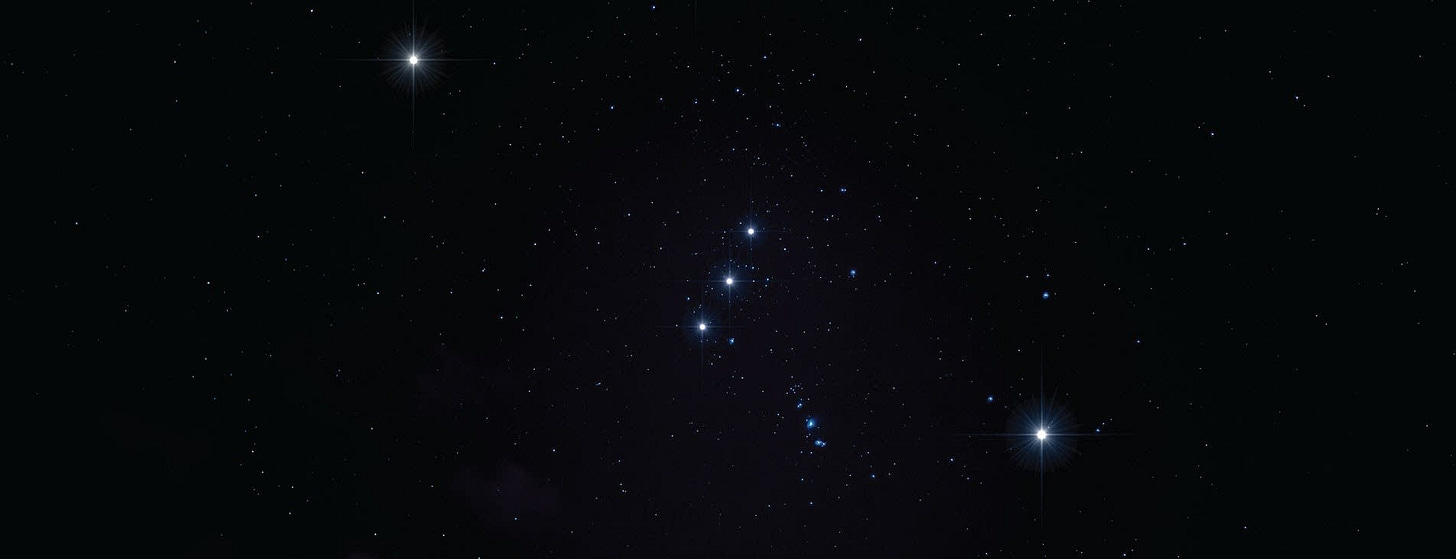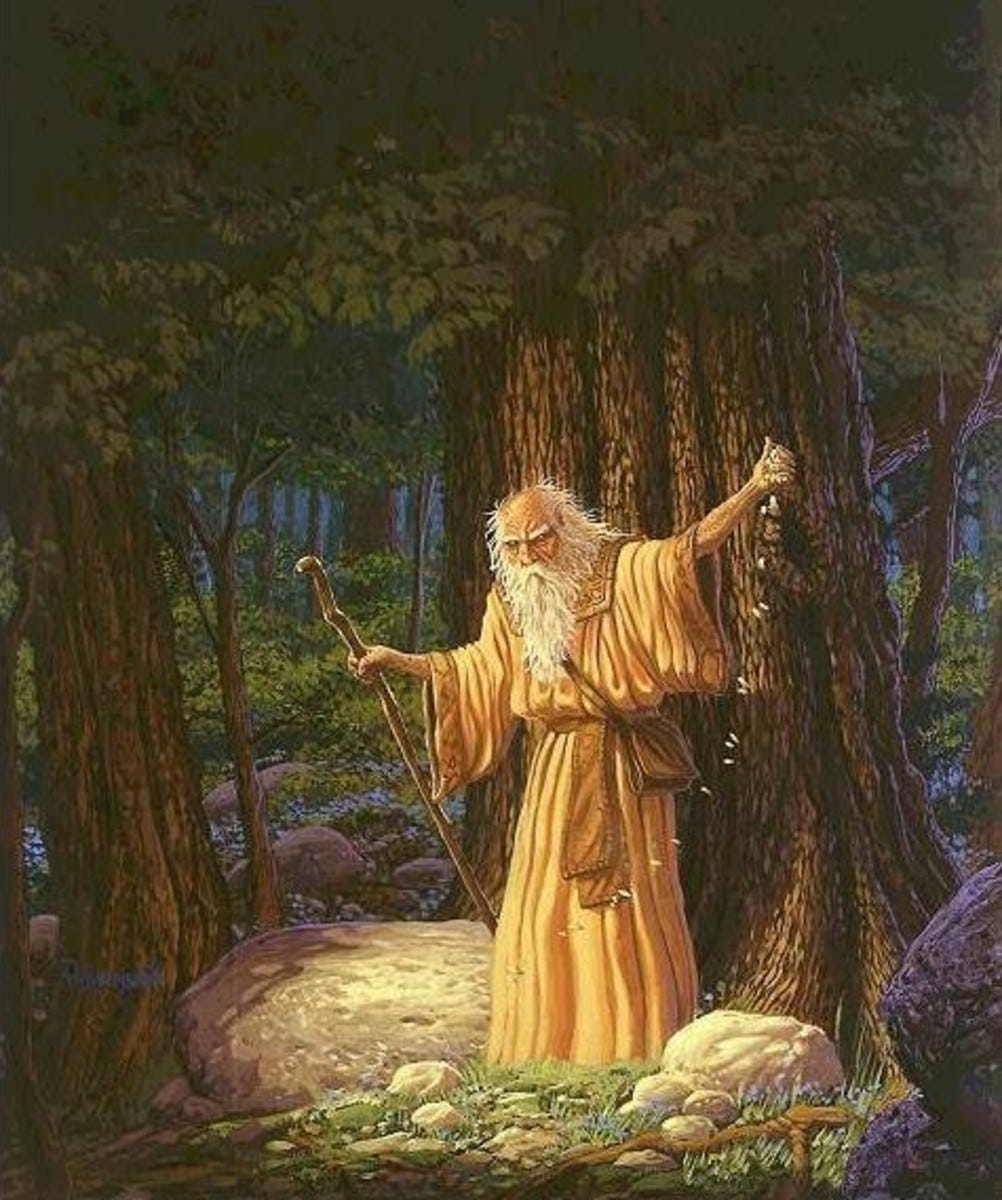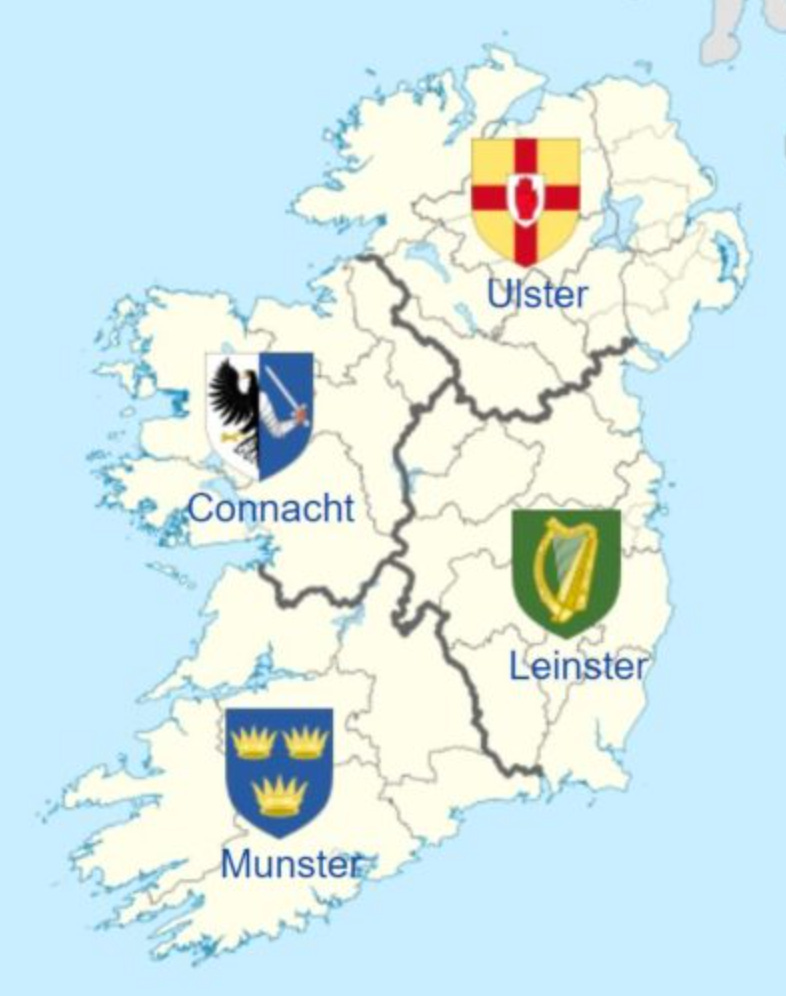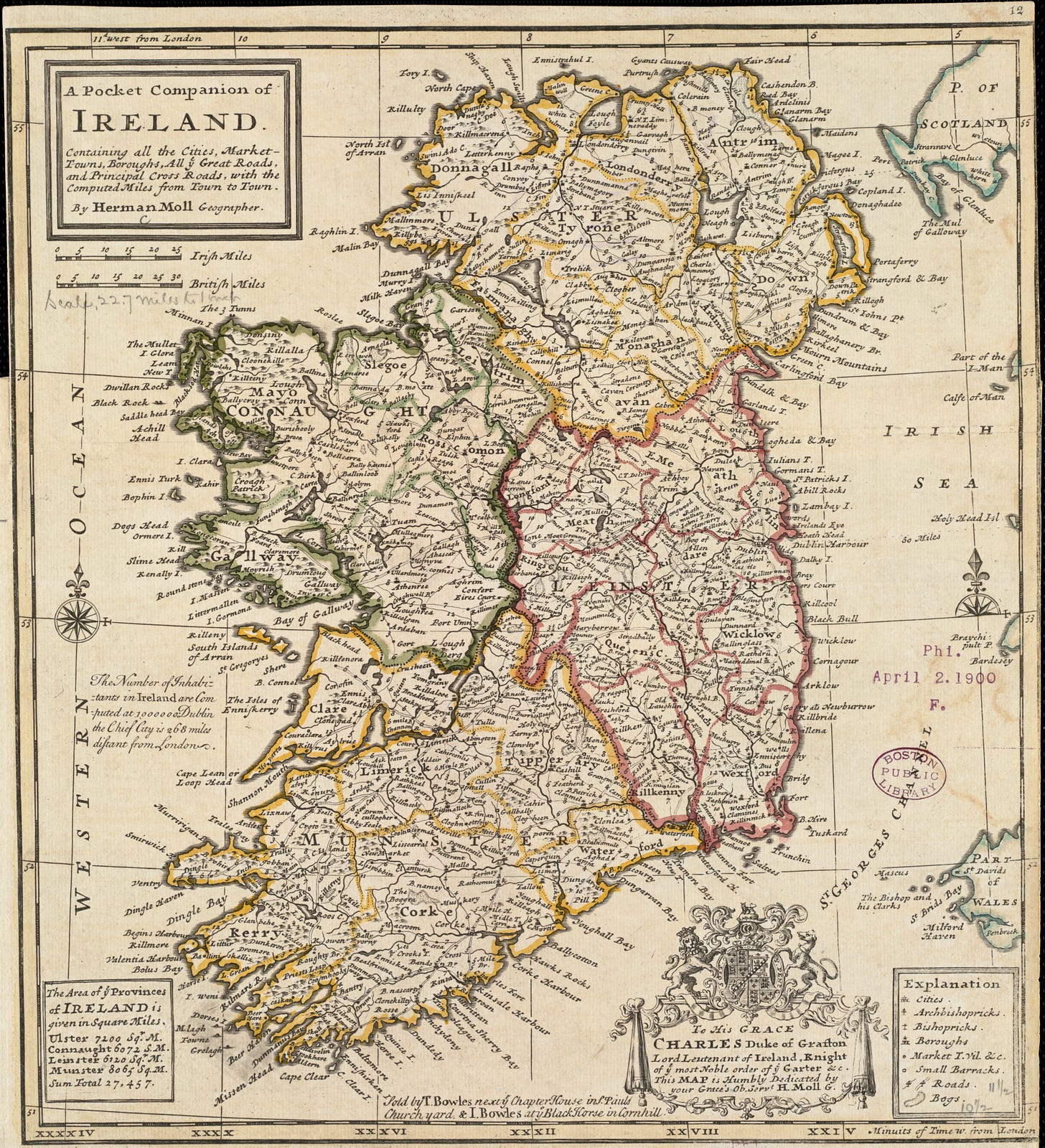Ancestral Heritage, A Journey of Discovery, Part 2
A journey into the winter night sky of the Irish countryside, Old Irish, Egyptian pyramids, the Hopi mesas, and the warrior archetype.
This is my longest post to date. It is something I have needed to write about for some time so it has come out in restrained bursts along the way. I may come back to edit it further for that reason, or continue to expand on it. But the story is here. I hope you enjoy it or are at least inspired by it.
It was my first night alone in the Irish countryside. Having slept off the jetlag in a quiet Dublin flat for 3 days, I had found my way down to the Wicklow mountains. Not where I had expected to begin my journey to commune with the oaks of Ireland but here I was, following the river of inspiration.
Being a cold November night, and I had some exploring to do in the morning, I was to bed early not long after the sun. My tiny cottage was oriented north-south with a wall of windows facing east; my bed, also facing east. Around 10:30p I awoke with a sudden jolt and sat up immediately. For the first time since arriving in Ireland a few days prior, I could see the night sky, the stars glistening. Alert and focused I said to myself in my mind, “Slatanrí… the king’s sceptre”.
This was what I saw just above the horizon as I looked to the east. The rising of Orion’s belt, slanted a bit, but nearly vertical. I rarely saw it in this near vertical position so suddenly it all came clear. I hadn’t discerned that translation before, but somehow, suddenly I knew.
Orion’s belt, rising in the east
Some years ago, I had paged through several Irish sources in search of all words connected to the root word of my surname. I was known as “Slatts” in high school and I knew what a slat was on a fence, but I hadn’t given it much thought until I saw all these Irish root words in a book. I started to feel like I was onto something. Evidently, the root word of our last name was “slát”.
Okay, so how does that relate to “strong”? On the notecard of every surname trinket, any book, or any website, I’ve read our name to mean “strong”. Okay, I can live with that. I had little initiative to look beyond that for some years. Then as I paged through a list of several words and phrases in which the root word slat was used, I began to gain a deeper sense of the multi-layered meaning of our name. I saw a trajectory, a history, a corruption of terms - and, thus, the people associated with them - that were dictated to a people by their oppressors - the tyrants.
Slat, as I came to understand, can refer to anything that is long and thin. It can also be used in the description of a tall, lithe young man. It may also be directly translated as a “rod” or a “switch”. Such a thing is often used to beat animals with or to cause them to submit to one’s will. A slat saille, for example, is a willow rod, or a switch of willow. This could be taken off the tree and used to commandeer cattle or an unruly horse. Further, it may be employed to discipline an unruly child (a practice, I sense, has only been with us for so long and was a consequence of experienced and inherited, unresolved trauma). Slat, as a verb, means “to beat with a rod”.
I was starting to get the picture. Someone with the name Slátara, for example, was considered “strong” because they were accustomed to taking the switch without complaint. This strength (to endure - thank you, oak) may have been viewed as an admirable trait, especially amongst a group of traumatized individuals, as one who can take the beating without complaint makes things easier for those around them - until, of course, they are forced to live out, unconsciously, their unresolved trauma, more succinctly, on their immediate loved ones. I was relating to this story…
But that seemed too tragic for me to accept as the whole story, for I had seen more about my ancestral past and there were more words within this genre that spoke to me of an ancient past more honorable and in tune with my own heart’s knowing. For the telling of a tale can be misconstrued by not only a slight misrepresentation of the truth, but also in the not telling, in the omission of fact.
Not only could a slat be used for sustenance as in a fishing rod (slat iascaigh), but also the ceremonial stick such as the slat draíochta, or “Druid’s staff”, or the slat ríoga, the king’s sceptre. Slát an Rí, or Slátanrí, can also be directly translated as “the sceptre of the king” or “the king’s sceptre”. Again, this is the name of Orion’s belt in Old Irish, and on that night I could see clearly why it was. But was there more to that association than just a creative means to describe the night sky? Yes, I believe so, and I will get to that in time.
As I first contemplated the use of this root word of our surname in such sacred terms as that of a druid’s staff or the king’s sceptre, I could begin to feel a deeper connection to the truth of who I am and where I come from. This connection I had only ever faintly, or briefly experienced upon connecting with forms of my ancestral heritage, such as a “man of the forest” which upon reflection is not unlike the image above.
I cannot adequately explain the awareness I experienced upon deeply connecting with my ancestral heritage at this time. It was in a way I had never felt possible. I felt like I had not only a right to exist (by the love and life of my ancestors), but as if there was a purpose to live written in my blood that was carried, now by me, upon the backs of my ancient ancestors. To have an idea of this is very different (as in being told to be proud of where you come from) from having the feeling and knowing emerge from deep within you. This is what I was discovering and it was the land of Éire that was awakening it within me.
In part, I began to see how the inversion had taken form within not only my cultural heritage, but in my family lineage. As I understand it, in ancient Ireland, the sovereignty of rule was governed by the extent to which a king would hold true to his responsibilities of protecting and providing for the people, but most importantly how he would conduct himself as an ambassador of Mother Earth with honor and integrity and the respect he showed for this sacred partnership.
Today we see corporate greed and industrial waste products as spoiling to the Earth. What about the times before industrialization and maritime admiralty law (law of commerce) taking over the Earth? How did one transgress the Earth, our mother? How did one turn away from her for their own selfish goals at the expense of the many? Perhaps through aggression and greed as well, motivating a desire to take for oneself regardless of the destruction, regardless of the suffering; to turn away from higher pursuits and to act dishonorably, to act and speak without integrity. Today it is no different, only on a much grander scale, and institutionalized.
The symbolic representation of a king’s authority was his sceptre. This staff, or rod, is a symbol of the masculine rule, in protection of the people and in service to the living Earth herself - a true king. Upholding this relationship with honor and integrity brought peace and abundance to the land and its people. Causing that to invert has brought chaos to the minds and hearts of men and ushered in an era of false tyrannical kings.
I have since come to know about a concurrent symbol of the feminine, known as the staff. This is rarely spoken about. The vertical staff receives the horizontal rod which unites the masculine/feminine principles merging the heart field awareness into one (Orion’s belt is known as “Freya’s staff” in Scandinavia). This concept is not commonly addressed (not overtly) in the Irish, or Celtic, traditions, but I feel that it is inherent within if not evidenced within the construction of ancient sites aligned to key positions of the sun’s (and in some cases, Orion’s) trajectory from along the horizon throughout the seasons. The tactics of perversion and inversion have succeeded in hiding many things from our sight and deranging our understanding of who we truly are and the nature of the world around us causing us to feel we are captives when we are truly free.
Do limitations exist from within the potential to realize a greater expression of self, just as the guiding force of material progress carries within it its own destruction?
According to author Gary David, the 3 mesas of Hopi (all fingers of Black Mesa which is the entire shaded area in the map above) are in an arrangement and alignment very similar to the 3 pyramids at Giza in Egypt. It was Robert Bauval (it’s hilarious how all the top hits on Google declare it’s Robert Duvall, the actor - AI is perhaps more prevalent, and idiotic, than we care to imagine), a Belgian engineer, who first drew the conclusion in his 1994 book, The Orion Mystery, that the 3 pyramids pointed directly to the belt stars of Orion - over 10,000 years ago. This discovery came as a consequence of robotics exploring the mysterious shafts of the king and queen’s chambers and the use of stargazing software which can project the nighttime sky back as far as you care to view it (assuming we truly know the continual rate of movement of all stars in the sky…). This discovery and declaration was groundbreaking as it takes us even deeper into the fascination (and dedication) the ancient Egyptians had with Orion which was believed to symbolize not only the mythic ruler, Osiris, but was the literal pathway of the departed souls to the land known to the Egyptians as Duat, ruled over by Osiris.
What author Gary David is explaining is similar to the idea of geoglyphs. However, the outline of Orion in the landscape could not be discernible by the naked eye, unless perhaps from out in the stratosphere, as it covers such a tremendous amount of the landscape. Yet it’s important to note that the proposed orientation on the landscape would allow for the constellation to be viewed on the ground from space just as we see it in the heavens from Earth.
This means that the first star in the belt of Orion to rise above the eastern horizon, known as Mintaka, would correlate with Hopi third mesa. As such, the Hopi mesas, David posits, are showing us a mirror image of Orion on the ground - as above, so below.
This connection between Egypt and Hopi was fascinating to me. There are other rabbit trails I could take us down here but that may lead us into a world of increasing speculation and absurdity, or perhaps closer to the truth of our past. But having lived in Arizona for 2 decades and having spent some time with the Hopi where I learned a bit about their culture of sun worship, I will share something else I’ve come across in my study of ancient Irish. The author Conor MacDari mentions several Irish names for the sun in his revealing book of 1923, Irish Wisdom Preserved in Bible and Pyramids. One of which is Isona. The author doesn’t describe which characteristics of the sun this Irish word conveys, but my mind grabbed this word and played with it. I added the prefix Ari-, a word denoting high and noble, rare, sophisticated which relates to Sanskrit and Old Irish, coming up with Ari-isona, or Arizona - ‘the land of the Aryan people of the sun’ or ‘the land of the noble sun worshipers’.
Now Aryan is not what you may think it means. That’s another perversion/inversion, in a long list, perpetrated on the people to confuse us and cause us to more easily lose our way. I see this word, as do other researchers such as Michael Tsarion (who is of both Indian and Irish descent) as a reflection of a once global culture that was ethnically related as a consequence of their shared culture, but not specific to any one race. I give Michael Tsarion a great deal of credit for all the work he has done peeling through the onion skins of history (and collective psychology) as he has to produce a report on the pervasive fraud and chicanery (as well as collective trauma from natural disasters) perpetrated for centuries on the otherwise free people of the world. He is the first person I heard speak, years ago, on the relevance of the Hegelian dialect in our world today. Since 2020, many people site the control program of problem-reaction-solution to which this refers, but he’s been onto this for many years. Also, his work came to me as I dove into the landscape of Ireland, arriving at just the right time to be corroborated by my personally intimate and intense experiences with the landscape.
While on a trip with authors Gary David and Graham Hancock in 2019 in Arizona, I learned that Orion is often referred to as a hand. This “hand” is often considered the hand of a warrior king. Interesting, I thought… sounds like the red hand of Ulster (another Irish-Orion connection). I’ve come to learn that the Lakota view Orion as the arm and hand of a Lakota chief, the belt stars forming the wrist. This commemorated chief once had his arm torn off - sounds like the great king of the Tuatha Dé Dannan, Nuada Airgetlám, “Nuada silver arm/hand” who lost his arm in battle. Fallen Star, a warrior demigod born of an Earthly mother and celestial father, answered the call to help the chief and win the hand of his beautiful daughter in marriage. Just like Miach, Diancecht’s son, who infused feeling and motion into a hand of silver crafted for Nuada by Credne (Luke Skywalker anyone?), Fallen Star did the same for the nameless Lakota chief creating a bond between the gods and the people of the Earth lasting to this day.
In Ireland, there are heraldry flags for each of the four main provinces. The flag of Connacht is dissected in two halves with a black eagle over a white, or silver, background and the right half consisting of a left arm, bent up at the elbow holding a sword. This is known as “the sword of light” of Nuada, or claíomh solais an Nuáda. The left half is meant to portray the regal Irish O’Brien family, descended from the great Brian Ború of the late 10th century, the High King of Ireland (I’ve sat beneath a great oak in East Co. Clare declared to have stood when Brian was crowned as king). Well, the O’Briens are known to be a sept of the Dalcassian clan, and O’Slátara, from Co. Clare, are recorded as part of this clan. County Clare is in the northern section of Munster, its flag consisting of 3 crowns. An alternate name for Orion’s belt is “the three kings”.
The Sword of Light was one of the Four Treasures of the Tuatha Dé Dannan. The flag of the Dalcassian tribe (similar to that of the right half of Connacht’s flag) features the Sword of Light in Nuada’s right hand. In this case, the arm is extended outwards with the elbow bent at an open angle causing the sword to point back above the head of Nuada. After viewing this image enough times, I began to see it as Orion’s torso with the forearm as his waist, or the sword as the belt and the forearm as the sash and Rigel as the head.
Dalcassian flag with Nuada’s Sword of Light
The connections to Orion within my ancestral homeland of County Clare were too great to fully digest and assimilate. Due to its great antiquity, and so very little extant available knowledge of these traditions, it is very much within the distant fog of history (perhaps, in many cases, intentionally so).
I’ll tie this loop up for now with one more related reference to give us a broader context. Many of you may have already watched Graham Hancock’s Netflix series Ancient Apocalypse. Graham’s work has for years referenced the widespread stories from throughout the Americas and beyond about the ‘bringers of civilization’ that so often appeared after the Great Flood. These men, known as sages, were often described as being of tall stature, light-skinned, blue-eyed, bearded, and in white, flowing robes. This, unfortunately, has been commandeered into a campaign to paint Graham as a racist which is sincerely ridiculous as I know Graham to be a kind-hearted, empathic, and exceptionally giving man. But one reference Graham hasn’t mentioned is that of the Hopi and the Bahana. Today, this is the common word used in Hopi to describe any non-native, or “white” person, but in the historical context this word has much greater meaning. As I understand it, there is a legend amongst the Hopi about the return of the ‘great white brother’ or Bahana - the return. This is not too dissimilar from the legend of Quetzalcoatl, the plumed serpent of central Mexican heritage (the Druids were often referred to as serpents, or serpens, men of knowledge) who was prophesied to return from across the ocean to the east on plumes of clouds (not unlike the Fir Bolg in Irish mythology, or Manannán MacLír, or others arriving from Tír na Nóg from beneath the waves to the West, essentially both coming from the same location, traveling in opposite directions). Many Hopi, to this day, as I understand it, have been waiting for the return of the Bahana.
If Gary David is correct, then the Hopi mesas are the center point of a vast configuration of the skies written on the Earth across the Southwest - in step with the Hermetic philosophy ‘as above so below’. As I understand it, certain rituals or ceremonial doings are conducted by the timing of Orion’s appearance through the opening of the kiva (not unlike the alignments Bauval and co. discovered with the Egyptian pryamids).
Irish author and photographer, Anthony Murphy, has claimed to find a correlation between a decorated kerb stone (K52) at Newgrange (Brú na Boinné), a major megalithic site along the River Boyne in Ireland, and the belt stars of Orion. In fact, it’s been claimed that the majority of celestial alignments in Ireland relate to Orion. I can no longer find the reference, but years ago I found a map of Ireland’s ancient roads which were traced out into the figure of Cuchúlainn, the famous warrior of Ireland. This form could be viewed as Orion, the warrior.
I find it interesting that Ireland, ancient Egypt, and the Hopi have this common connection to, and admiration for, Orion. In Andrew Power’s book, Ireland: Land of the Pharoahs, he details the Hermetic maxim as above, so below through the relationship of Orion and the Milky Way to the pyramids and the Nile as I’ve already alluded to. But Power takes it further in relating this same phenomenon to the Boyne River valley in Ireland. Just as Orion and Sirius lie on the right bank of the Milky Way (and the pyramids on the right of the Nile - facing upriver), so, too, do the ancient mounds of Newgrange, Knowth and Dowth (not their ancient names) lie on the right bank of the River Boyne. Consequently, translated back into Irish the River Boyne means “Milky Way”. Further, claims author Conor MacDari, Nile is an Irish word, from fuil, meaning “blood”, we have the genitive form n’uil, or Nile.
Andrew goes to great lengths to show us how the Battle of the Boyne in 1690 was a highly ritualized event meant to reunite lost tribes through the coronation of the Osirian Sun King William III. It’s a fascinating read and I highly recommend it.
Upon my first visit to Ireland, I met up with a Michael Slattery. Although he was born in County Wicklow, he migrated west in search of his ancestry. Nestled into a tiny hamlet of County Clare on the border with County Galway he had been living quietly and researching his family history. When my host got wind of my interest in my family heritage she was sure I needed to meet with Michael. What I learned is that he’d traced his Slattery lineage back 900 years. These distant ancestors of his (which are likely of the same lineage as myself) were mercenaries in service to the king. In other words, the physical representation of the king’s authority, his force on the battlefield, his ability to protect his people, their dignity, and their wealth. Whereas, his slát rioga, or slátanrí, was the symbolic, or ceremonial, representation of this authority. They were the king’s “strength” and by whom respect was given him for his upright manner of carrying his slát ríoga - it’s no wonder where they got their name. It was all lining up.
My sense of connecting to something much greater than myself, a living lineage within my bloodstream that connects to the land of my ancestors and the stars above gave me an immense sense of pride and humility, simultaneously. This knowing of being a part of something grand, almost inconceivable, yet potentially destructive gave me great cause to ponder these connections more deeply.
I am still pondering the vast possibilities of these connections, many more than I have yet described here as to the origins of our civilization on Earth, and the source of the knowledge and the wisdom that has allowed us to flourish in all the material ways we have over the eons. I am pondering what happened to us, when did we become so oriented towards war, and how (no, I don’t accept that we’ve always been this way, that ‘it’s human nature’; I feel there is something else at play)? Because although I see that there has likely been a demand to express aggression perhaps over the great history of humankind on Earth, I sense that warfare, as we’ve known it for millennia, is something that has not always been part of our existence. And if so, then where did it come from, by whom, and how?
And is the way of the warrior one to be a ‘slave to war’, perpetually fighting other humans, just causes or not, or to be a spiritually vigilant being in physical form continuously seeking honor through integrity of thought, speech, and action?
The latent ability of humankind to become strong warriors does not mean to me that we must always be fighting, or that there is an inherent need to go to war, or that there is no honor without war. I am pondering whether these ideas are part of an ancient psychological operation on what we call the human race.










